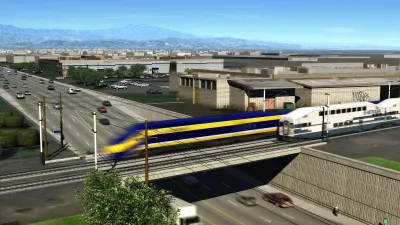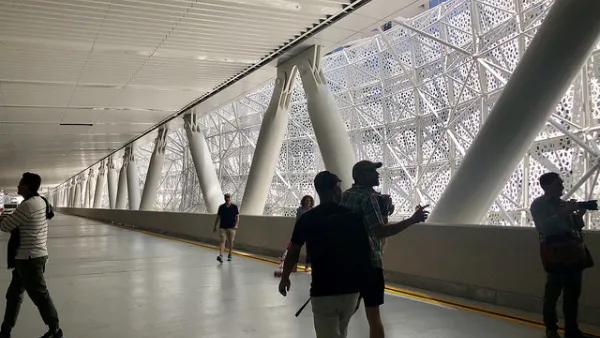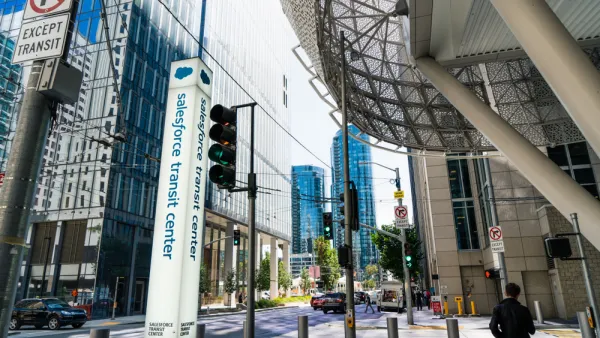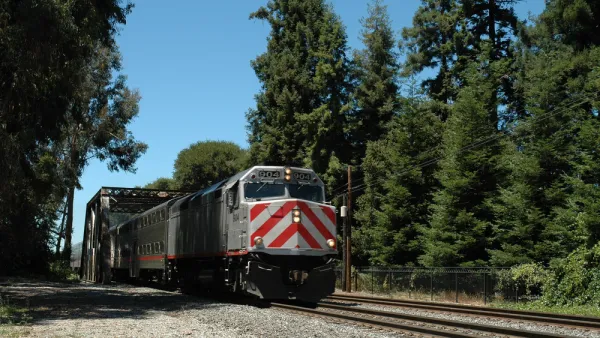A San Francisco Chronicle editorial warns that San Francisco must find funds, intended to come from the state's ambitious rail project, to extend the Caltrain commuter rail line to the SalesForce Transit Center.

There is some irony here for those who follow flawed mega-transit projects, as this is a story that connects two of them in California:
- The realization by California's new governor that the nation's most expensive public works project cannot succeed as currently planned.
- A new $2.2 billion transit center that had to close just over a month after opening due to structural problems. It is expected to reopen by June at the earliest.
With Gov. Gavin Newsom's dramatic downsizing of the high-speed rail line linking San Francisco to Los Angeles to a 119-mile stretch from Merced to Bakersfield in the Central Valley, the Transbay Joint Powers Authority will lose access to state high-speed rail funds to complete the Caltrain Downtown Extension.
"Officials in San Francisco had planted their dreams in the empty concrete box beneath the Transbay Transit Center [aka Salesforce Transit Center], calling it an end point for Caltrain commuters from the Peninsula and bullet trains zipping in from Southern California," reported Rachel Swan for the San Francisco Chronicle on Tuesday, the day Gov. Newsom delivered in state-of-the-state address with the stunning news on the high-speed rail project.
Now, that may not happen for decades. It might not happen at all.
"San Francisco — which was counting on high-speed rail to be a major tenant in its $2.2 billion transit center in the South of Market neighborhood — needs to respond accordingly," writes the Chronicle's editorial board.
Specifically, it needs to figure out a new plan to bring Caltrain to the terminal that doesn’t rely on funding from high-speed rail. The city was depending on bullet-train funding to extend the underground rail line from Caltrain’s 22nd Street station to Mission Street.
"So far, the city has only identified $1 billion in local sales-tax and bridge-toll revenue for what probably would be a $6 billion project; the rest would come from a mix of federal and state sources, including funds earmarked for high-speed rail," wrote Swan.
As for Caltrain, which runs 50 miles up the Peninsula from San Jose to San Francisco, its executive director, Jim Hartnett, issued a statement indicating that Gov. Newsom's announcement would not impact the state's $713 million contribution toward the electrification project, underway since July 2017. Last year, "the State awarded an additional $165 million to support the purchase of additional electric trains."
"The Caltrain extension isn’t high-speed rail by a long shot, but it will still help activate the neighborhood’s businesses and new residences," continues the editorial, but it's the difference between the transit terminal becoming the Grand Central Station of the West or Billion Dollar Bus Station.
San Francisco needs to focus on what it can do to make the Transbay Transit Center a success. Its first priority must be securing funding for the Caltrain extension.
FULL STORY: Editorial: San Francisco must salvage the Caltrain extension to the Transbay Transit Center

Analysis: Cybertruck Fatality Rate Far Exceeds That of Ford Pinto
The Tesla Cybertruck was recalled seven times last year.

National Parks Layoffs Will Cause Communities to Lose Billions
Thousands of essential park workers were laid off this week, just before the busy spring break season.

Retro-silient?: America’s First “Eco-burb,” The Woodlands Turns 50
A master-planned community north of Houston offers lessons on green infrastructure and resilient design, but falls short of its founder’s lofty affordability and walkability goals.

Test News Post 1
This is a summary

Analysis: Cybertruck Fatality Rate Far Exceeds That of Ford Pinto
The Tesla Cybertruck was recalled seven times last year.

Test News Headline 46
Test for the image on the front page.
Urban Design for Planners 1: Software Tools
This six-course series explores essential urban design concepts using open source software and equips planners with the tools they need to participate fully in the urban design process.
Planning for Universal Design
Learn the tools for implementing Universal Design in planning regulations.
EMC Planning Group, Inc.
Planetizen
Planetizen
Mpact (formerly Rail~Volution)
Great Falls Development Authority, Inc.
HUDs Office of Policy Development and Research
NYU Wagner Graduate School of Public Service




























